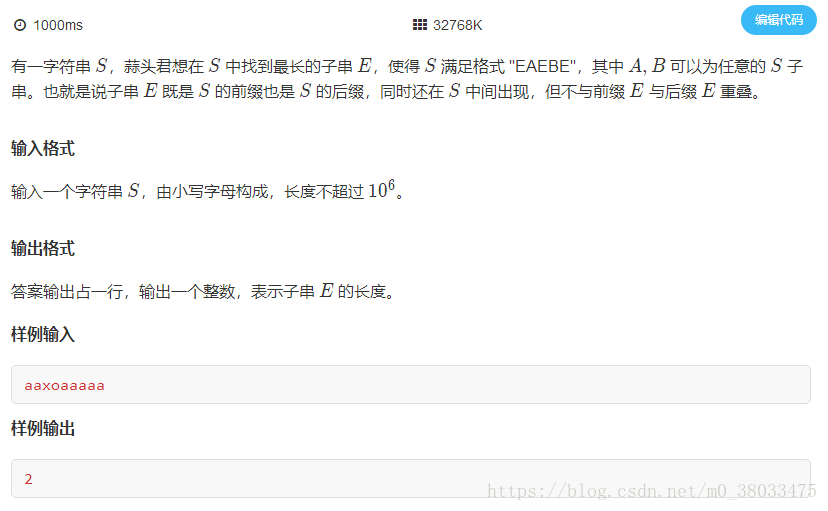
大致思路:
耶这道我自己比较顺利地做出来了。
为什么联想到要用拓展kmp呢?其实你看看,首先是有“头尾匹配”的,只不过花样多了点。
这道题我是通过getnext()先把所有next值得到。需要注意“不重复”的题意要求,所以自己由此加了些限制条件:
nextt[i]+1<=i //中间部分与头不重复
n-q.top().len+1>q.top().i+q.top().len-1 //中间部分与尾不重复然后一个优化是“从大到小枚举”,首先这个长度肯定是要小于等于n/3的,而且我要找最大,所以从大到小开始枚举,符合条件就立马结束程序即可。所以这里用到“优先队列”,想让其以长度从大到小排序。这里优先队列的元素是结构体,自己赶紧去温习了一下之前写的博客,原来对于这种情况,是让结构体定义中多加一个bool operator<函数,然后男左女右女士优先原则。
自己觉得!!真的这种题,干瞪眼在那里想真的不如拿起笔写几个例子!!其实写例子分析其中关系就是在转化为数学思维考虑了!!对于写程序给思路和全面考虑情况很有帮助。以后没思路就多写例子吧。
AC代码:
#include<iostream>
#include<bits/stdc++.h>
using namespace std;
#include<queue>
const int maxn=1e6+5;
int nextt[maxn];
int n;
char t[maxn];
void getnext()
{
nextt[1]=n;
int a=0;
for(int i=1;t[i]==t[i+1];i++) a++;
nextt[2]=a;
int k=2,p,l;
for(int i=3;i<=n;i++)
{
p=k+nextt[k]-1;
l=nextt[i-k+1];
if(p-i>=l) nextt[i]=l;
else
{
int j=p-i+1;
if(j<0) j=0;
while(i+j<=n && t[1+j]==t[i+j]) j++;
nextt[i]=j;
}
k=i;
}
}
struct node
{
int i;int len;
bool operator < (const node &a) const
{
return len<a.len || (len==a.len && i>a.i);
}
node(int ii,int ll)
{
i=ii;
len=ll;
}
};
priority_queue<node> q;
int main()
{
scanf("%s",t+1);
n=strlen(t+1);
getnext();
for(int i=1;i<=n;i++)
{
if(nextt[i]!=0 && nextt[i]<=n/3 && nextt[i]+1<=i)
{
// cout<<i<<" "<<nextt[i]<<endl;
q.push(node(i,nextt[i]));
}
}
while(q.empty()==false)
{
// cout<<"!"<<q.top().i<<" "<<q.top().len<<endl;
if(nextt[n-q.top().len+1]==q.top().len)
{
if(n-q.top().len+1>q.top().i+q.top().len-1)
{
cout<<q.top().len;
return 0;
}
}
q.pop();
}
return 0;
}
最后
以上就是潇洒火最近收集整理的关于【扩展kmp+优先队列(结构体)排序】匹配格式的全部内容,更多相关【扩展kmp+优先队列(结构体)排序】匹配格式内容请搜索靠谱客的其他文章。
本图文内容来源于网友提供,作为学习参考使用,或来自网络收集整理,版权属于原作者所有。








发表评论 取消回复